Hens and chick are also called Houseleeks and Sempervivum. These succulents are fun to grow, and transplanting Hens and Chicks encourage better growth and a great chance of success.
The Hens and Chicks are transplanted due to various reasons. It supports the plant’s propagation and gives the plant better growing conditions and many more things. But how can we transplant a hens and chicks plant?
To transplant hens and chick plants, take the plant out of the pot and clip the adjoining roots connecting the chicks with the mother plant. Once done, prepare a fresh soil mix, dig a 2-inch deep hole and plant the chicks into it. With proper care, you will have a thriving plant in no time.
In this article, you will get to know the benefits of transplantation and a step-by-step guide on doing it correctly. Along with that, we will also share with you some simple care tips to keep your Hens and chicks flourishing.
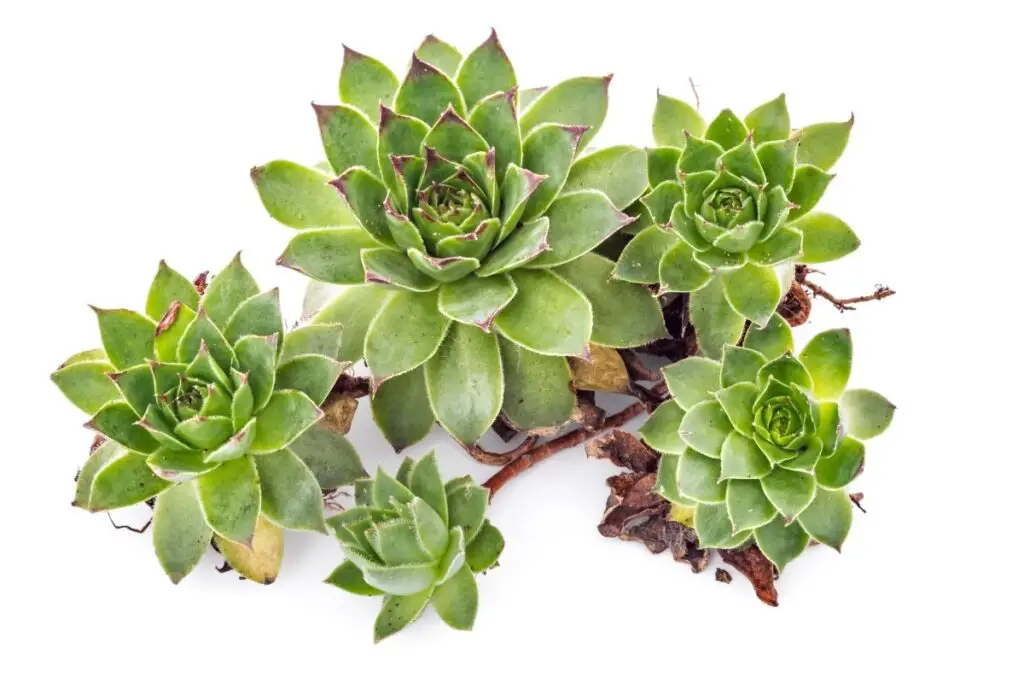
Why should I transplant Hens and Chicks?
Transplantation benefits the plant’s health. Let’s see how:
Separating the chicks from time to time and transplanting them gives the mother plant space to produce more chicks.
Hens and Chicks are known to produce lots of young offsets.
Some varieties produce 2 to 6 chicks in one growing season.
Some other varieties will deliver as many as 10-15 chicks in one season.
As a result, the mother plant gets surrounded by many chicks.
Separating them from time to time gives the mother plant more space in the surrounding.
Due to this, the mother plant will again produce lots of chicks to cover the space.
The more area you give them, the more they will reproduce for 3 to 4 years.
Looking for gardening supplies? We have tested 100's of products before recommending them to you guys. Check out our best pick below:
| Image | Gardening Supplies | Best Price? |
|---|---|---|
 Top
Top Top
Top | Raised Garden Bed Kit | Check On Amazon |
 | XLUX Soil Moisture Meter, Plant Water Monitor, Soil Hygrometer Sensor for Gardening, Farming, Indoor and Outdoor Plants, No Batteries Required | No Results |
 Top
Top Top
Top | 82 Pcs Garden Tools Set and Extra Succulent Tools Set | Check On Amazon |
 | Joeys Garden Expandable Garden Hose with 8 Function Hose Nozzle, Lightweight Anti-Kink Flexible Garden Hoses, Extra Strength Fabric with Double Latex Core, (50 FT, Black) | No Results |
 Top
Top Top
Top | Dual Chamber Compost Tumbler | Check On Amazon |
 Top
Top Top
Top | Sunnyglade Plant Stakes | Check On Amazon |
 Top
Top Top
Top | Organic Cold Pressed Neem Seed Oil | Check On Amazon |
 Top
Top Top
Top | Mighty Mint Gallon :-Insect and Pest Control Peppermint Oil | Check On Amazon |
 Top
Top Top
Top | Scotts DiseaseEx Lawn Fungicide | Check On Amazon |
 Top
Top Top
Top | Jacks Classic 20-20-20 All Purpose Fertilizer | Check On Amazon |
 Top
Top Top
Top | 30,000 Seeds Pollinator Attracting Wildflower Mixture | Check On Amazon |
 Top
Top Top
Top | Survival Vegetable Seeds Garden Kit-Over 16,000 Seeds | Check On Amazon |
Transplanting the chicks to propagate will give you more Hens and Chicks.
When you think of transplanting the Hens and chicks to improve their growing conditions, you can also propagate them by separating the chicks.
When you dig out the Hens and chicks to grow it somewhere, along the process, divide the chicks and plant them too.
By this, you will get more plants and also allow the mother plant to produce more chicks.
Also read: How To Propagate Hens And Chicks? (A Step-by-Step Guide)
Transplanting is necessary when the plant suffers root rot.
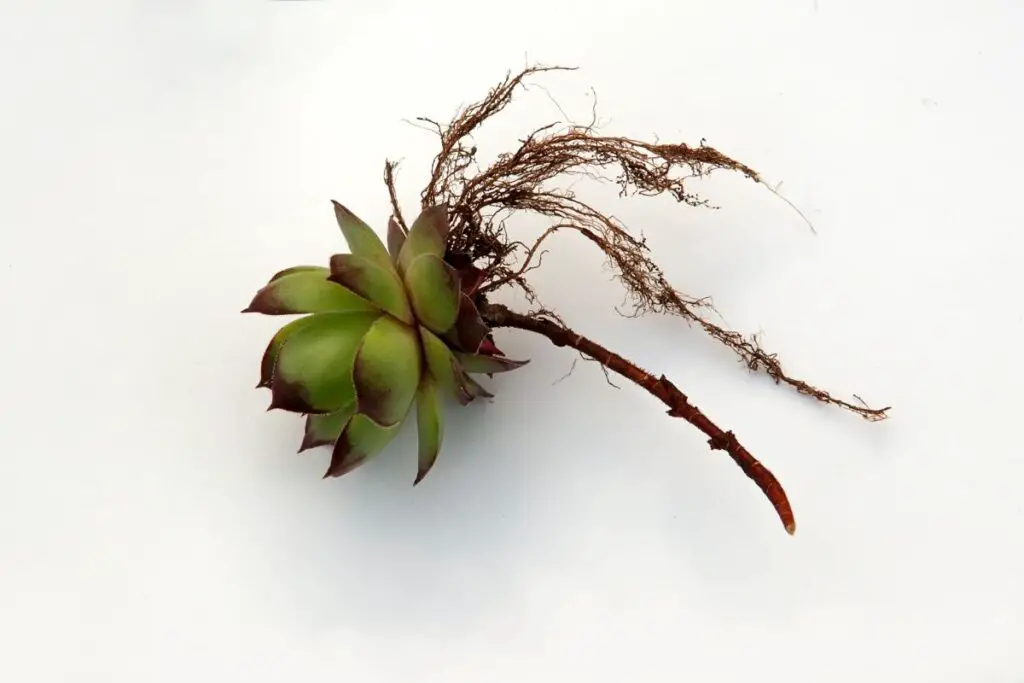
When your Hens and chicks experience prolonged overwatering and root rot, the soil remains damp for lengthy periods.
It mostly happens if the soil is not well-drained.
You have to dig out your Hens and chicks and plant them in some dry locations in such conditions.
The current position will have too much moisture.
That is why shifting the plant to a dry area helps them recover quickly.
Make sure the soil is well-drained.
Dig up the planting site and mix some gritty materials like sand or gravel.
It will improve drainage.
The plant requires transplantation when they suffer pest infestation.
When your plant suffers from pest infestation, it is better to isolate them by transplanting it to a distant location.
It prevents the pests from spreading to other plants around in good health.
The plant will be transplanted when they are not getting proper sunlight in its present location.
More or less, all the varieties of Hens and Chicks require sunlight for at least 6 to 8 hours.
If you have mistakenly planted your Hens and Chicks at a site that receives shade, you have to transplant them to a sunny spot.
It happens when you plant the plant in a place surrounded by tall trees and buildings.
They block the sunlight and prevent it from reaching the bed.
Without adequate sunlight, the plant will look pale and start rotting.
Generally, we think they only require transplantation to separate chicks, propagate them and give the mother plant more space.
But other than these, transplantation is done due to various other reasons.
It not only allows the plant to breathe or produce more offsets, but it also improves the plant’s health to a great extent.
Also read: Why Are My Hens And Chicks Rotting? (Causes+How To Fix)
How often should I transplant Hens and Chicks?
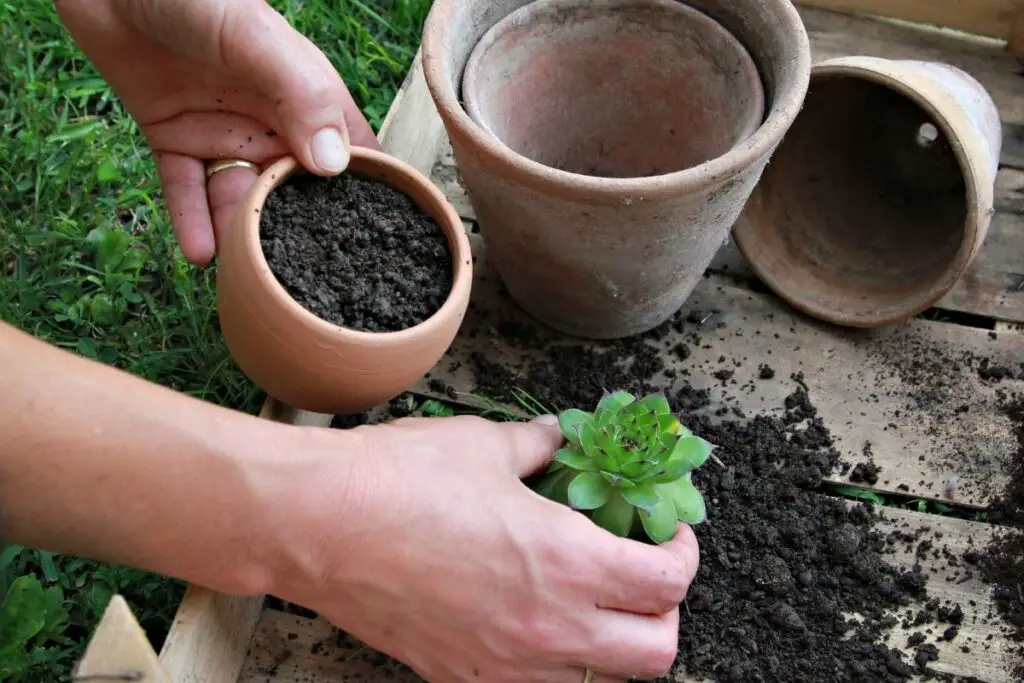
In general, you can do it every year.
But there is no fixed timing to transplant Hens and Chicks.
Transplanting is quite different from repotting.
Outdoors, the plant can stay in the same soil for years provided they did not suffer any diseases like root rot.
Transplanting is only needed when the mother plant gets surrounded by lots of chicks.
Dividing them from time to time allows the mother plant to breathe and reproduce further.
By transplantation, you are propagating them for more plants.
Transplanting due to rotting, low light, and infestation are a sort of emergency.
There is no fixed frequency here.
Whenever you find signs of discomfort in the plant, you should check its condition, identify the problem, and transplant if necessary.
How to transplant Hens and Chicks?
Transplanting Hens and Chicks is very easy and does not require much effort.
Transplanting chicks for more space and propagation
- Take the plant out of its original position.
- Divide the chicks very carefully.
- Remove maximum soil from the root portion of the babies and mother.
- Choose a place where they can receive sunlight. But make sure they don’t receive direct sunlight. The offsets won’t tolerate direct sunlight because they are young and didn’t develop roots yet.
- Prepare a separate bed for all the chicks. Dig up the place to aerate the soil and add 50% sand to improve drainage. Make sure that the soil bed must be well-drained.
- Later on, we will share some ideal soil mixes beneficial for Hens and Chicks.
- You can either trim off some stems from the chicks or let it stay. The young offsets will have long stems. If you trim off, prune at least 1-2 inches.
- Don’t overdo it. Since the chicks are tiny, they will require some support.
- After you cut off some inches of stem, dig a hole, about 1-2 inches, and plant it.
- Press the soil in the surrounding very well to block air pockets.
- Water them after 3-4 days.
- You can also change the mother plant’s position with the chicks if you want. It can improve its health.
- When you divide the chicks, the mother plant gets space to produce more chicks.
Transplantation for problems like root rot or low light conditions
The steps are pretty similar to the previous one. Just a few changes are required.
- If the Hens and chicks seem weak, inspect the plant.
- If you find that the plant is not growing, the leaves are turning pale or black, inspect the soil and the roots.
- If the roots are black and mushy, the plant has root rot. Low light conditions will also rot the plant.
- Take the plant out of its position.
- Remove maximum soil from the root portion. You don’t need to wash the roots. They are already wet enough due to excessive moisture.
- Also, remove the damaged leaves like black, rotted, deformed, or stretchy leaves.
- Prepare a bed that is dry and receives a good amount of sunlight.
- Go for the southern, western, and eastern directions to select the right spot. These directions get the maximum amount of sunlight.
- The bed should not stay saturated all the time. If the soil bed is near a fountain or rooftops, water can constantly fall upon the soil bed and keep it saturated. Avoid such areas.
- Dig up the whole soil bed and mix porous materials like sand or gravel. It will improve drainage.
- Place the plants properly, spread the roots and cover them with soil.
- Press the surroundings to block any air pockets.
- If all the roots are damaged, you can remove the whole part. This succulent is capable of growing new roots.
Transplanting the Hens and chicks to any other ideal location helps the plant recover quickly and improves its health.
If your plant is suffering from any pest infestation, first treat them with some insecticidal soaps so that you can approach for help by touching.
Then transplant them somewhere else so that it doesn’t spread.
Follow these above steps for transplanting and continue to treat them with insecticides.
For a small infestation, you don’t have to transplant them. Do it if it’s big.
Also read: When To Repot Hens And Chicks? (Signs, How-To & More)
How deep should I plant Hens and Chicks?
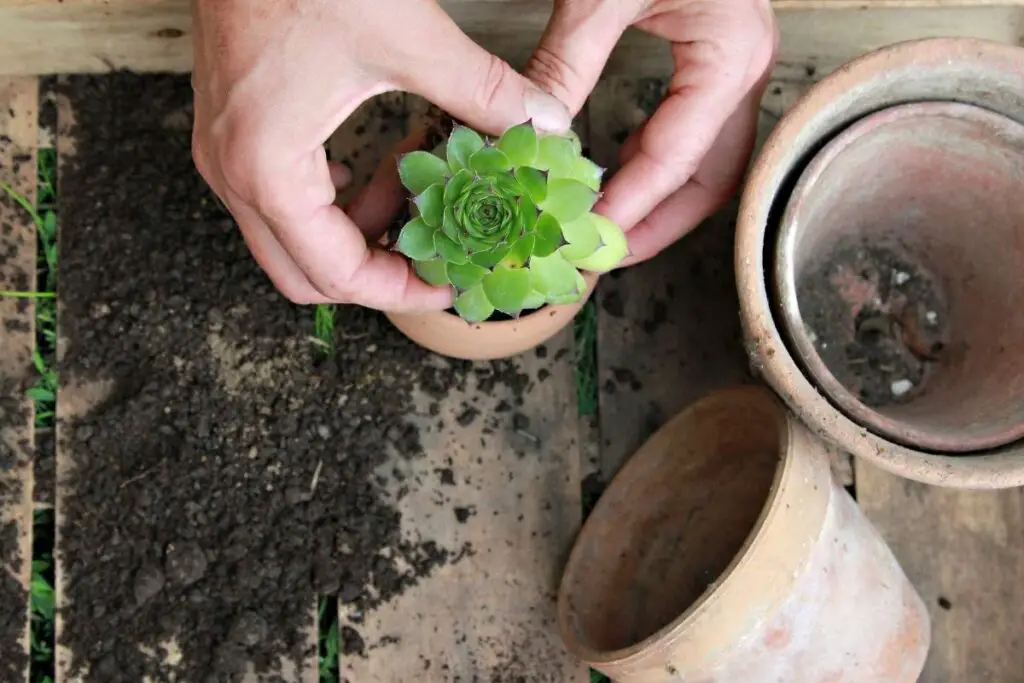
Hens and Chicks will grow up to 6 to 12 inches in height and 6 to 18 inches broad.
Some varieties, especially the dwarf variety, will rarely cross 3-4 inches in height.
Generally, these succulents are groundcovers and don’t grow tall.
As a result, their roots do not develop much deep.
In some regions, they are grown on the roofs without any difficulties.
It must be clear from the above explanation that Hens and Chicks have shallow roots.
So, they don’t require deep planting. Dig a hole in the ground of 3-4 inches for planting. It will be enough for them.
Along with depth, also take care of the spacing between the plants.
As they are groundcovers, Hens and Chicks can spread from 18 inches to 2 feet.
So, while planting, maintain at least 4 to 6 inches of space.
Once they produce chicks, constantly separate them for space, especially those measuring 1-inch in diameter.
They will grow faster than the smaller ones.
Also read: How To Plant Hens And Chicks In A Pot? (A Step-by-Step Care Guide)
What kind of soil is suitable for Hens and Chicks?
When we transplant Hens and Chicks, two things are essential – location and soil.
For an ideal location, I have already mentioned that you need to choose a sunny spot for them.
I have also mentioned some appropriate directions.
Coming to the soil, it should be well-drained and porous.
Otherwise, the plant will suffer root rot.
Prolonged damp conditions are also responsible for fungal infections.
Though these plants are resistant to it, you should still stay careful.
Hens and Chicks require well-drained soil with a pH level of 6.6 to 7.5.
They don’t need to stand over high-nutritious soil.
Instead, it makes the plant stretchy.
If you don’t have any soil mixes near to you, for now, you can dig up your planting site and mix only sand. It will work.
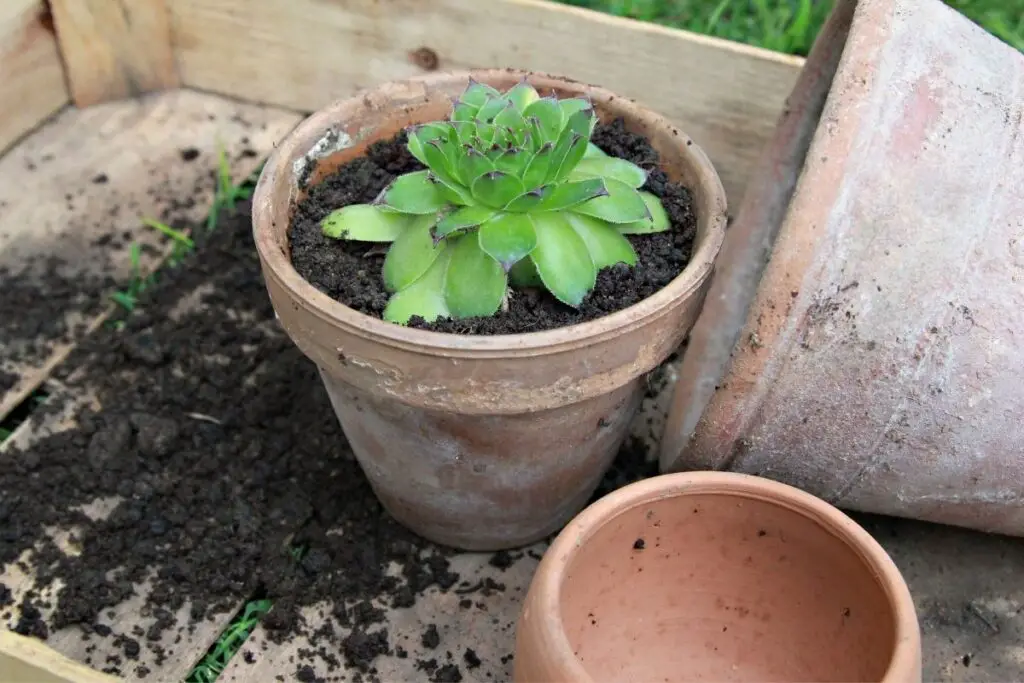
For improved and better results, follow the following soil mix recommendations:
Recipe 1:
- 25% Potting soil
- 50% Sand
- 15% Perlite/Vermiculite
- 10% Compost/Worm casting
Recipe 2:
- 50% Succulent and cactus mix
- 25% Sand
- 15% Perlite/Vermiculite
- 10% Compost/Worm Casting
Recipe 3:
- 50% Garden soil/Potting soil
- 50% Sand
- A handful of Compost
Also read: What Kind Of Soil Do You Use For Hens And Chicks? (+Best Soil Mix)
How to care for Hens and Chicks?
Let them have adequate sunlight for at least 6 to 8 hours.
For the dwarf varieties, use shading nets to filter direct sunlight.
Keep a shade of about 1-2 weeks for young offsets.
If you don’t fix a sunny spot during planting, you have to transplant them later on for adequate light.
Water the Hens and chicks only when the top few inches of soil are dry.
Instead of following a routine, check the soil moisture daily to understand water needs better.
Generally, you can water them once a week throughout their growing season.
Fertilizing is not mandatory. Still, you can feed the plant during the spring.
It boosts them and increases their growth and reproduction pace.
Cut back watering during the cold months. Else, they will suffer root rot.
Plant them in well-drained soil. Follow the soil mixes I suggested for better consequences.
Remove the chicks and propagate them timely to allow the plant to breathe, get space and reproduce more young offsets.
Check the plant daily to watch out for pest infestation. Fixing a small infestation is easy.
But if it increases, you have to put much more effort than only transplanting them.
Final thoughts on transplanting Hens and Chicks
Transplant the Hens and Chicks whenever necessary.
Eventually, Hens and Chicks will need transplanting at one point in time.
It can be propagation by separating chicks, low light, root rot, or pests.
Don’t wash the roots for cleaning them after taking them out of the soil.
Clean as much as you can with your hands. For propagation, after separating the chicks, prune off some stems if it’s too long.
Check the plant’s condition regularly. Don’t overwater them and let them have adequate sunlight to encourage healthy growth.
Reference: Wikipedia, Iowa State University of Science and Technology, The University of Arkansas Division of Agriculture, NSDU, The Ohio State University, Missouri Botanical Garden.
